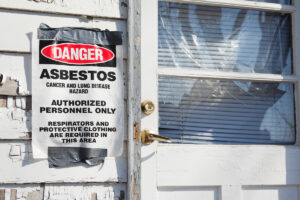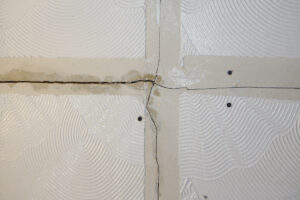Mesothelioma / Asbestos / Where Is Asbestos? / Asbestos in Paint
How to Tell if the Paint on Your Property Contains Asbestos
Before asbestos use was banned, the toxic mineral was used in a variety of paint and other building materials. If you’re in a building that was made before asbestos was banned, the paint could have dangerous amounts which is hard to tell.
Get Free Mesothelioma Guide
Asbestos in Paint
A toxic mineral once used for its resilient and non-corrosive properties, asbestos was once hailed as a “miracle” mineral. As a result, manufacturers used asbestos to reinforce a number of tools, materials, and buildings for decades. This included paint.
From approximately 1945 until at least the 1980s, asbestos was manufactured into spray paint that was applied to form textured and popcorn ceilings. This type of dangerous paint was once very popular because of its insulation ability. Asbestos was commonly used in fire-retardant painting of other building materials like siding, drywall, plaster, and roof coatings, among others.
The Mesothelioma Connection
Asbestos is toxic because it contains small, spindly, fibers that can easily become airborne and then inhaled by living things. Once this happens, it’s easy for workers or other people who are nearby to inhale the fibers. After that, the invasive fibers may get lodged in the lung, stomach, or even heart tissue linings, then irritate and damage them.
Asbestos also causes other lung illnesses like lung cancer and asbestosis.
Tumors that grow in the lung tissue lining (pleura), are the most common form of mesothelioma. Cause and symptoms of the disease are often difficult to notice and pinpoint as the latent illness often takes over 10 years to develop after asbestos exposure.
Where Is Asbestos Paint Found?
Paint reinforced with asbestos isn’t very dangerous when it’s intact. Only when it’s in a friable (or crumbled) state. In other words, when asbestos-contaminated paint is in a worn-down and dilapidated building where the paint is peeling off and chipping away. This form poses the highest risk to anyone nearby.
Buildings built before the 1980s that have a higher risk of housing these types of paints are:
- Schools
- Military barracks and training facilities
- Old apartment complexes
- Ships and shipyards
- Most houses
Real Estate Agents
Real estate agents selling property contaminated with asbestos paint should take care of how they handle the situation. Most state regulations mandate the agent to disclose all knowledge of asbestos or any other toxins or carcinogens present. But not always. Disclosure is key to avoiding litigation if anyone gets sick.
Real estate agents can test for the mineral if they suspect it’s on the property, but they don’t have to test for or remove it. The real estate agent can sell the property “as is.” Some local entities require testing for asbestos and other toxins in specific buildings and complexes.
Building Owners
Building owners or managers owning property contaminated with asbestos are legally required to adequately remove it before allowing workers or residents to occupy the infrastructure.
National and local entities passed laws to ban asbestos as well as enforce the removal of the mineral in specific situations.
Asbestos causes latent mesothelioma. Think you were exposed?
Evaluate My Case
How to Test for Asbestos in Paint
If you own real estate and want to check for asbestos, find a local, certified firm to come and take the samples and test for you. The Environmental Protection Agency (EPA) does not advise testing or removing yourself.
When the asbestos tester arrives, they will remove samples of material from the suspected area. After that, they will send the samples to a lab to test and then relay the information back to you.
The National Voluntary Laboratory Accreditation Program (NVLAP) has a helpful directory for people to search for and find accredited laboratories to test asbestos.
How to Remove Paint with Asbestos in It
Since asbestos is so toxic to human health and requires medical center treatment, laws exist that regulate its proper handling and removal. Unfortunately, the removal of asbestos encourages toxic fibers to become airborne. As such, there are specific regulations in place that those involved in asbestos abatement (removal) services must follow.
Consequently, if you’re looking to hire a company to remove asbestos from your property, they must be certified and professional. More harm than good can come from improperly handling an asbestos removal project. Additionally, if you’re working with other people to remove the toxin and they develop mesothelioma or other illness, you can be liable for their injury.
Can You Paint Over Asbestos Paint, Textured Ceiling, or Siding?
Building owners or managers have some options for handling dangerous levels of asbestos on their property. They can encapsulate the mineral. This involves treating the asbestos-containing material (ACM) with a sealant that adequately surrounds or encases asbestos fibers. Encapsulating also encompasses penetrating and applying an adhesive mix that will properly bind the materials together. So technically, you can “paint” over asbestos paint, textured ceiling, and siding, as long as you do it with a compound that satisfies legal encapsulation criteria.
The other options are to build a structure that completely covers the dangerous asbestos or completely remove it from the structure or material.
Keep Yourself Safe
Workers that remove asbestos must make sure to wear proper personal protective equipment (PPE). PPEs are clothing and coverings that employees use to help protect themselves from contact with harmful materials while on the job. These can involve overalls, respirators, gloves, and boot coverings among other things.
Mesothelioma Support Team
Mesothelioma Hub is dedicated to helping you find information, support, and advice. Reach out any time!

